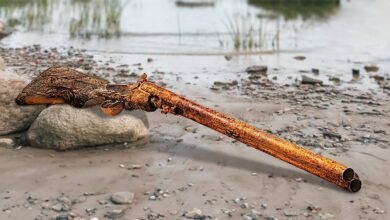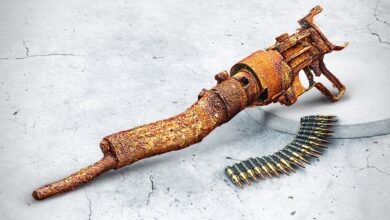Old Guns Restoration: A Look at the SA-26 AK-47
Old guns, particularly military firearms, hold a certain mystique. They represent history, craftsmanship, and often the technological advancements of their time. Restoring these weapons, especially iconic ones like the AK-47, involves more than just fixing cosmetic damage—it’s a careful, detailed process that balances historical accuracy with modern engineering.
In this article, we will take a closer look at the restoration of one such legendary firearm—the SA-26 AK-47—and explore why restoring old guns like these is a blend of art, history, and technical skill.
The Legacy of the AK-47
The AK-47 (Avtomat Kalashnikova 1947) is perhaps the most recognized assault rifle in the world. Designed by Mikhail Kalashnikov, the rifle was initially developed in the Soviet Union during the late 1940s. It was built for durability, simplicity, and reliability, with the ability to function in harsh environments, from mud to sand to extreme temperatures. Its rugged design and widespread use in conflicts across the globe have made it a symbol of revolution, warfare, and power.
The SA-26 variant of the AK-47, particularly, represents one of the earlier iterations of the rifle, often seen in military and guerrilla hands during the Cold War. Its construction may vary slightly depending on the manufacturer, but the core design and features remain remarkably similar across different versions.
The Need for Restoration
Old guns like the SA-26 AK-47 can show signs of wear and tear over the decades. From rust and pitting to stock degradation and mechanical malfunction, these firearms can suffer significant damage due to their age, exposure to the elements, or heavy use in combat. For collectors, military historians, and shooting enthusiasts, restoring an old gun to its original or functional condition is not only about preserving the firearm’s integrity but also ensuring its continued operational ability.
There are several reasons why someone would seek to restore an old AK-47 or similar firearms:
-
Preservation of History: Old guns are often seen as historical artifacts. Restoring them allows future generations to appreciate their craftsmanship and role in history.
-
Functionality: Over time, parts of an old gun can become worn out or even broken, which may compromise its functionality. Restoration ensures the firearm can still be used safely.
-
Aesthetic Appeal: Many gun enthusiasts and collectors value the look of an old, well-maintained firearm. Restoring an AK-47 can bring back its original finish and charm, giving it a renewed sense of beauty.
Key Aspects of Restoring an SA-26 AK-47
The restoration of an SA-26 AK-47, like any firearm, involves a number of steps. Here are the key processes involved:
1. Cleaning and Inspection
The first step in restoring any firearm is a thorough cleaning. After years or even decades of disuse, the metal parts of the AK-47 can become covered in dust, dirt, and corrosion. Professional restorers strip the rifle down to its individual components and clean each one carefully.
This may involve:
- Disassembling the rifle: Removing the barrel, receiver, trigger mechanism, and other parts for inspection.
- Rust removal: Using fine abrasives or specialized chemicals to remove any rust or corrosion on metal surfaces.
- Internal cleaning: Ensuring that the chamber, barrel, and other internal parts are free of debris and old grease.
2. Stock and Woodwork Restoration
The wooden stock of the AK-47 often suffers from cracking, warping, or fading over time. Restoring the stock is a delicate task that requires skill to maintain the balance between functionality and aesthetics.
- Sanding and refinishing: The stock may be sanded down to remove old stains or scratches. Afterward, a protective finish is applied to prevent further damage.
- Repairs: Any cracks or splits in the wood are carefully mended using wood filler, epoxy, or other materials to restore its strength.
- Recheck for alignment: Ensuring that the stock aligns perfectly with the rest of the rifle is essential for proper assembly.
3. Metal Refinishing
The metal parts of the SA-26 AK-47, including the barrel, receiver, and bolt carrier, can become tarnished or corroded over time. Restoring these components is a meticulous process that may involve:
- Bluing: This is a common method for protecting the surface of steel and giving it a smooth, dark finish. Bluing can also enhance the rifle’s visual appeal.
- Parkerizing: Some models, particularly military-issued rifles, may have a parkerized finish. This process involves coating the metal with a protective layer to prevent rust and improve durability.
- Replacing worn-out parts: Some components, like springs or firing pins, may be worn beyond repair. These parts are replaced to restore the firearm’s functionality.
4. Mechanical Repair and Testing
The mechanical function of the AK-47 is crucial. Once the rifle is reassembled, a professional will test the action, the trigger mechanism, and the magazine. They ensure everything is operating smoothly, with no failures or jams.
- Spring replacement: Springs in the firing mechanism and bolt assembly often wear out over time and need replacing.
- Headspace checking: The headspace—the area where the cartridge sits in the chamber—must be checked to ensure safety and functionality.
- Cycle test: The rifle must go through multiple test cycles to ensure it operates correctly, both manually and under fire.
The Role of Historical Accuracy
When restoring a firearm like the SA-26 AK-47, especially for collectors or museums, it’s essential to maintain historical accuracy. This includes sourcing original or period-correct parts where possible, preserving markings and stamps on the receiver, and adhering to the authentic finish. This attention to detail ensures that the restored rifle remains true to its original form, retaining its historical value and significance.
Conclusion
Restoring an old firearm, particularly a significant piece of history like the SA-26 AK-47, is a process that combines technical expertise, attention to detail, and a deep respect for the weapon’s heritage. Whether for preservation, functionality, or aesthetic appeal, the restoration of these iconic firearms allows them to live on, continuing to tell the stories of the past while ensuring they are ready for the future.
For those who take on this artful and intricate task, old guns restoration is not just a hobby—it’s a passion, a bridge between history and the present, and a tribute to the craftsmanship that once defined these legendary weapons.





